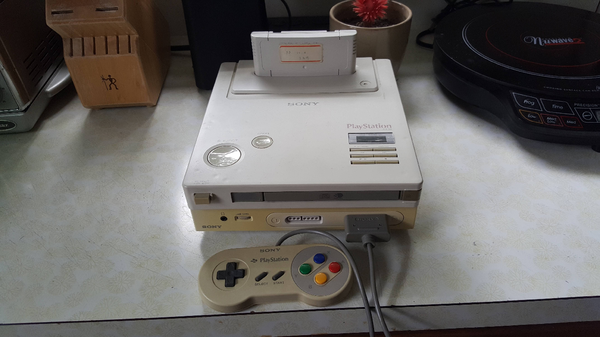Nintendo's Play Station discovered by chance
Posted on Jul 3, 2015

Just last night (July 2, 2015), a practical unicorn has been discovered in the world of retrogaming. Nintendo’s Play Station, once thought to be long lost in the famous squabble between Sony and Nintendo, has been discovered in a box of junk.
Originally posted on Reddit, this massive discovery was presented as a mere accident: Dan Diebold (Reddit user analogueboy) claimed that his father was given a box of items intended to be thrown away. Amongst computers and PA systems was the legendary console, in surprisingly good quality despite its yellowed plastic.
What exactly does this mean for gaming history?
A brief recap
The Nintendo Play Station began development in 1988 as the SNES-CD, a joint venture between Nintendo and Sony in an effort to produce a CD-ROM compatible gaming system.
Intended as a CD-ROM addon for the Super Nintendo (which was still in pre-release at this point), it had a rough and shaky lifespan. The companies’ relationship soured over the development process as Nintendo drew increasingly away from Sony for the device’s manufacture. Sony continued to press for production rights despite already having control over CD manufacturing, and Nintendo was hesitant to provide them.
Things reached a head at the 1991 Consumer Electronics Show, when Sony formally premiered their version of the SNES-CD (which they called the Play Station). A mere day later, Nintendo announced that they would be switching production of the SNES-CD to Philips, one of Sony’s major rivals. It wasn’t just their contract with Sony (which brought legal repercussions) that was broken, but also their business etiquette - by switching from a Japanese developer to a foreign one, and effectively throwing Sony’s work in the trash.
Tension took months to blow over, and their partnership did not recover. Allegedly only 200 Play Stations were produced by Sony during 1992 before the project was scrapped entirely. Meanwhile, although Nintendo managed to claim full rights over its games, the quality of games released for the Philips CD-i was widely considered abysmal and only live on in terms of mockery.
During 1993, Sony took a bold decision to manufacture the system independently under the name PlayStation. Nintendo did not produce a disk system until 2002 with the release of the Gamecube. Sony’s PlayStation became an international sensation, and Sony claimed a solid place in the video game market.
The console itself

Dan Diebold, lucky owner of the Nintendo Play Station, doesn’t happen to be a video game collector. His father, Terry Diebold, worked at a banking company called Advanta Corporation alongside company president Olaf Olafsson. Olafsson was the former CEO of Sony Interactive Entertainment, a Sony subsidiary that just happened to be responsible for creating the PlayStation.
Advanta’s bankruptcy (an event prompted by the 2008 financial crisis) was a key factor in this series of events: as Terry Diebold was commanded to effectively take out the company’s trash, he found a box containing the Play Station. Instead of throwing out, he kept it; this was a gesture that was equal parts mere curiosity and a hoarder’s complex.
Currently, Dan Diebold has no way of turning on the console or meaningfully interacting with it due to a missing power cable, but he has plans of buying a compatible cord. The console also came with a cartridge and CD, neither of which we currently know the contents of. More details are available in a relevant thread he has posted in at ASSEMbler.
We will be keeping you all informed with the latest updates in this recent discovery!
Tagged: nintendo sony retrogaming